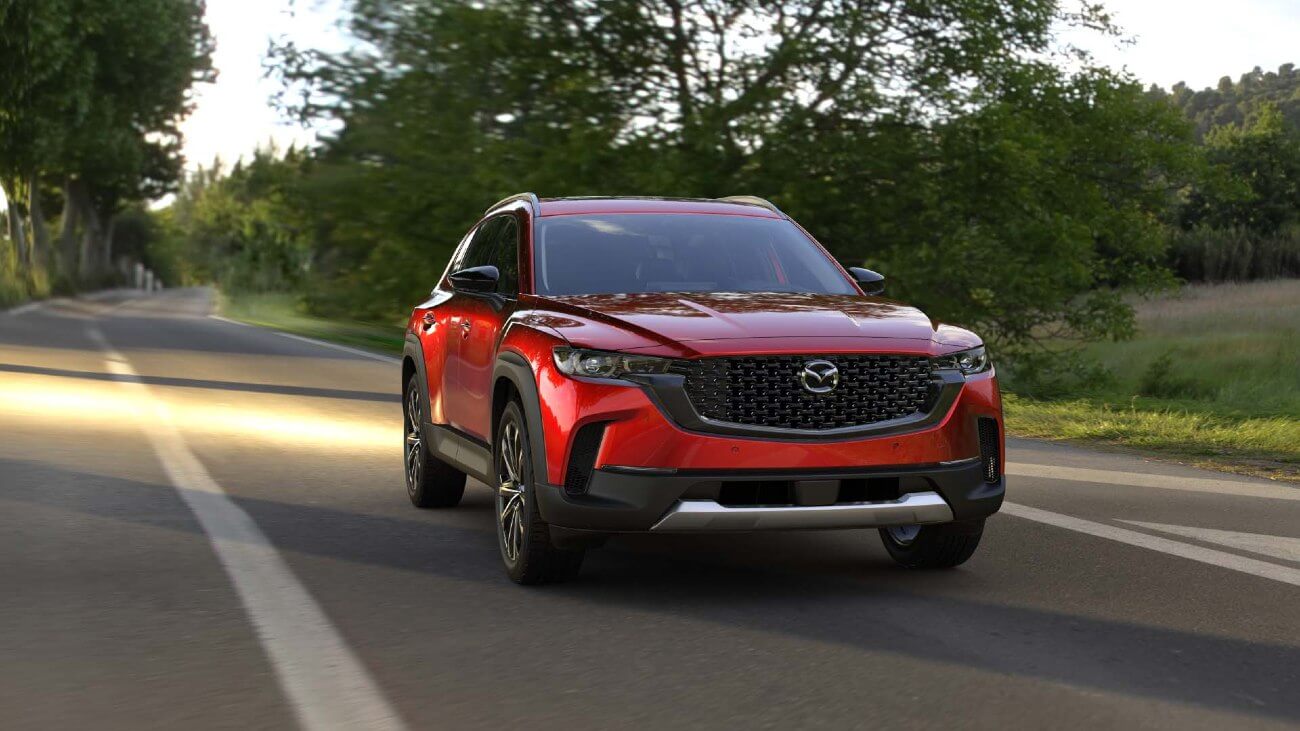Mazda CX-70 vs. CX-50: Compact & Midsize SUV Comparison
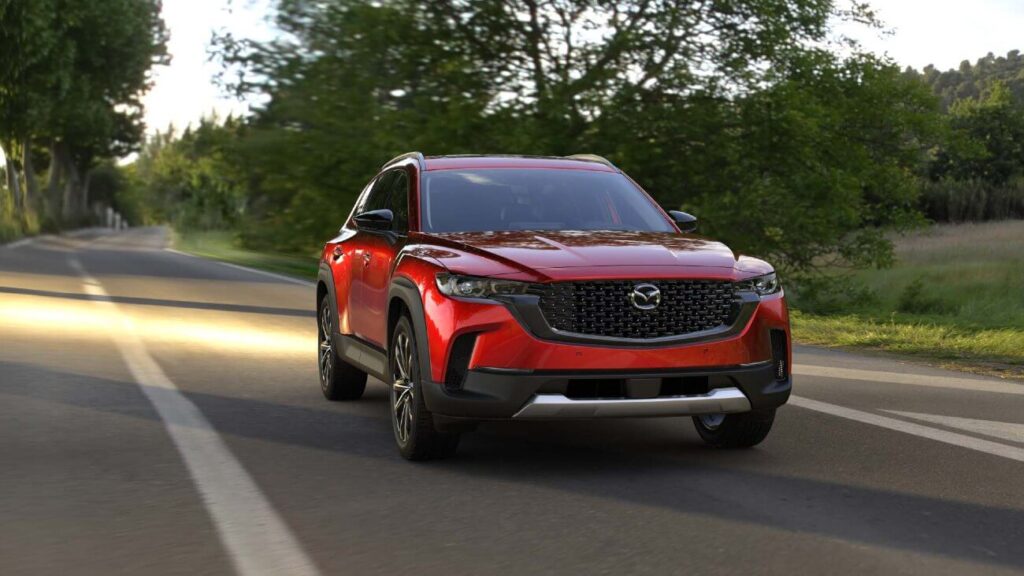
Drivers considering a two-row Mazda SUV as their next vehicle will want to compare the Mazda CX-70 vs. CX-50. The CX-70 midsize SUV arrives as a two-row variant of Mazda’s CX-90, while the CX-50 is the automaker’s take on a rugged and adventurous compact crossover SUV.
See our Mazda CX-50 vs. CX-70 comparison to discover the crucial differences between these two Mazda SUVs and determine which better suits your preferences.
Comparing Mazda’s New Midsize Two-Row SUV & Adventurous Compact SUV
When you compare the CX-70 vs. CX-50, you’ll find that although these SUVs represent different vehicle segments, their seating capacities are identical, and their passenger space and legroom are surprisingly similar. However, the midsize CX-70 holds several advantages regarding power output and cargo space.
Likewise, the CX-50 boasts its own list of benefits, including its agility and affordability, compared to the larger and more premium CX-70 line.
Let’s look closer at how the CX-70 and CX-50 stack up in specs, size, trim levels, and more to help you decide which two-row Mazda SUV is the better option for you.
Mazda CX-70 vs. CX-50: Dimensions & Size
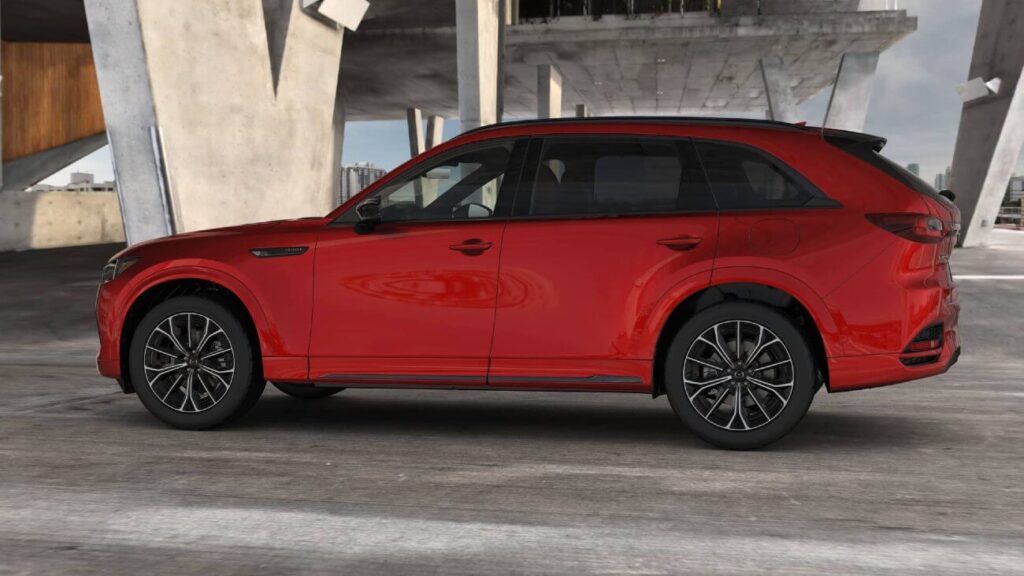
One of the two key differences between the Mazda CX-50 and CX-70 models is their dimensions. While both models feature two-row seating for up to five occupants, the CX-70 is significantly larger. It’s classified as a midsize SUV – and a large one at that – measuring over 200 inches long and riding on a 122.8-inch wheelbase it shares with its three-row sibling, the Mazda CX-90.
The Mazda CX-50 compact crossover SUV is shorter at 185.8 inches in length, with a 110.8-inch wheelbase. It’s also narrower than the larger CX-70 midsize model, which translates to the interior.
The midsize CX-70 boasts more headroom, shoulder room, and hip room than the narrower, low-slung CX-50 compact SUV.
However, these two SUVs are remarkably similar when comparing their first- and second-row legroom.
The compact CX-50 provides 41.7 inches of front-row legroom and a generous 39.8 inches of legroom in the second row. The longer Mazda CX-70 SUV’s front and rear legroom are nearly identical, at 41.7 inches and 39.4 inches or more in the rear, which features a sliding second row.
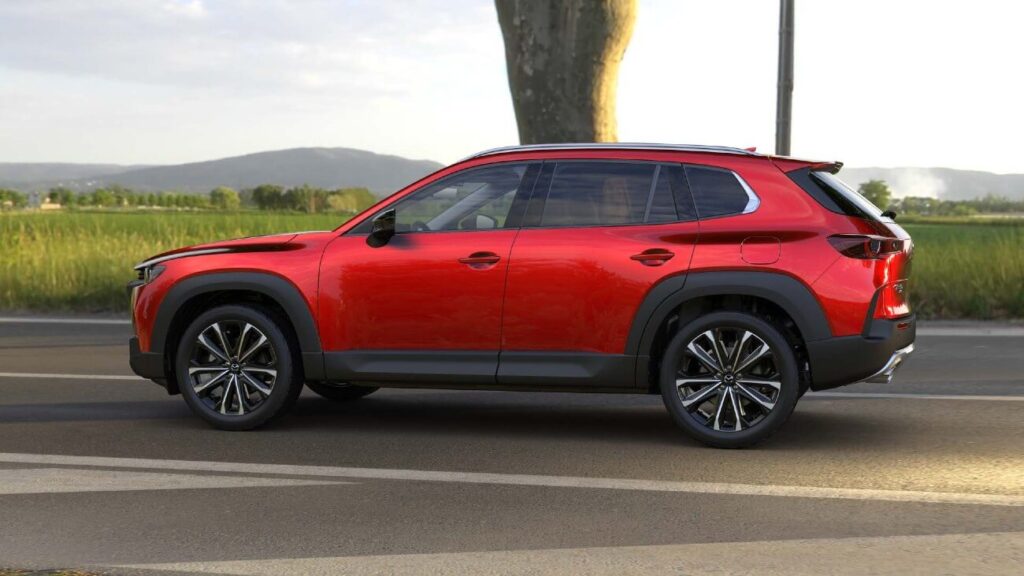
Instead of treating second-row passengers to substantially more legroom than the smaller CX-50, the new Mazda CX-70 adds space at the rear, in its cavernous cargo hold.
It starts with over 40 cubic feet of cargo space behind its second-row bench seat, which is significantly more than you’ll find behind the CX-50 model’s second row, measuring 31.4 cubic feet.
Lowering the split-folding second row in both models reveals another win for the larger and longer CX-70, as it provides over 75 cubic feet of maximum cargo capacity, compared to 56.3 cubic feet in the shorter CX-50.
Specs: Engines & Performance
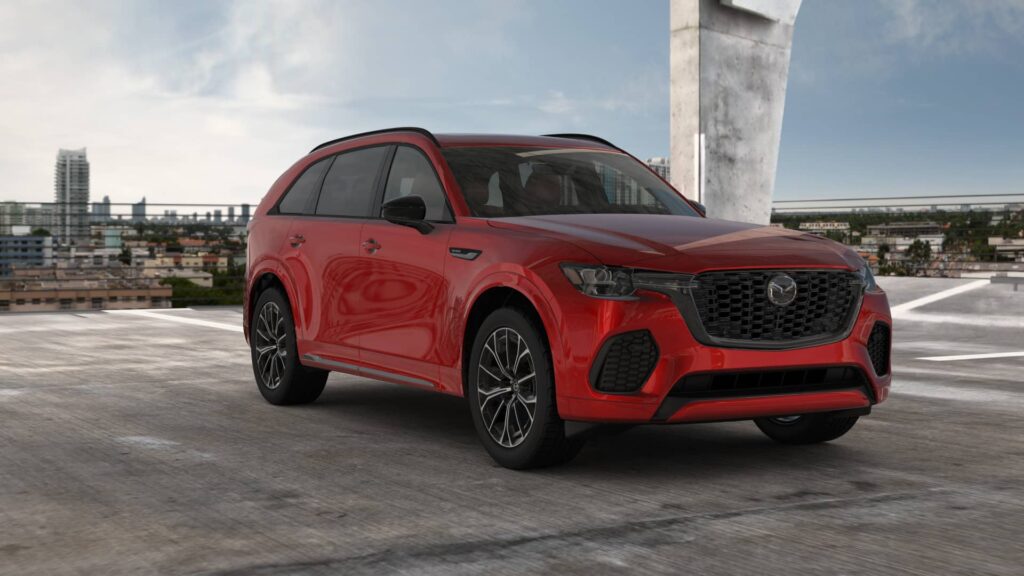
CX-50 & CX-50 Turbo Engines
The second critical difference between the Mazda CX-50 and CX-70 SUVs lies in the engines that power them. Both models offer a choice of two powertrains, but there’s no overlap between the two SUVs’ engine offerings.
The adventurous CX-50 compact crossover SUV is motivated by Mazda’s familiar 2.5-liter Skyactiv-G engine, either in standard naturally aspirated form or the available Skyactiv-G 2.5 Turbo powertrain, featuring a twin-scroll turbocharger.
Both of the available Mazda CX-50 engines are paired with the automaker’s tried-and-true Skyactiv-Drive six-speed automatic transmission and connected to a front-biased i-Activ AWD system.
Power output ranges from 187 horsepower and 186 pound-feet of torque in the non-turbo Skyactiv-G 2.5-liter inline four-cylinder engine to up to 256 horsepower and 320 pound-feet of torque in the Skyactiv-G 2.5 Turbo engine when running premium fuel.
Mazda CX-50 towing capacity starts at 2,000 pounds and reaches 3,500 pounds in turbocharged versions.
CX-70 Inline-6 & CX-70 PHEV Powertrains
Motorists looking for more power in a two-row Mazda SUV will want to consider the CX-70 midsize model, powered by the carmaker’s new inline six-cylinder turbo mild-hybrid system or a plug-in hybrid powertrain built on its 2.5-liter inline four-cylinder engine.
The new e-Skyactiv-G 3.3-liter Turbo I-6 engine powering the Mazda CX-70 develops 280 horsepower and 332 pound-feet of torque, or up to 340 horsepower and 369 pound-feet of torque in the high-output Turbo S variant when burning premium gas.
While the new Mazda 3.3-liter inline-six turbo engine is coupled with a mild hybrid setup, the CX-70 lineup also offers a plug-in hybrid model, offering a limited electric range.
The plug-in hybrid Mazda CX-70 PHEV model utilizes a 68 kW electric motor connected to a 2.5-liter gasoline engine to deliver up to 323 horsepower and 369 pound-feet of torque on premium fuel.
Like the CX-70 inline-six models, the CX-70 PHEV is equipped with a rear-biased i-Activ AWD system and an eight-speed automatic transmission.
Mazda CX-70 towing capacity reaches 5,000 pounds in the inline-six turbo models and 3,500 pounds when equipped with the CX-70 PHEV powertrain.
| CX-50 | CX-50 Turbo | CX-70 | CX-70 PHEV | |
| Engine | 2.5L I-4 | 2.5L I-4 Turbo | 3.3L I-6 Turbo | 2.5L w/ 68 kW electric motor |
| Horsepower | 187 | Up to 256 | Up to 340 | 323 |
| Torque | 186 lb-ft | Up to 320 lb-ft | Up to 369 lb-ft | 369 lb-ft |
| Transmission | 6-speed auto | 6-speed auto | 8-speed auto | 8-speed auto |
| Drive Type | Front-biased AWD | Front-biased AWD | Rear-biased AWD | Rear-biased AWD |
| Towing Capacity | 2,000 lbs | 3,500 lbs | 5,000 lbs | 3,500 lbs |
| Length | 185.8 in | 185.8 in | 200.8 in | 200.8 in |
| Wheelbase | 110.8 in | 110.8 in | 122.8 in | 122.8 in |
| Seating Capacity | 5 | 5 | 5 | 5 |
| Second-Row Legroom | 39.8 in | 39.8 in | 39.4+ in | 39.4+ in |
| Cargo Space | 31.4 cu ft | 31.4 cu ft | 40+ cu ft | 40+ cu ft |
| Max Cargo Capacity | 56.3 cu ft | 56.3 cu ft | 75+ cu ft | 75+ cu ft |
Mazda CX-50 vs. CX-70 Trims

The rugged and sporty new Mazda CX-50 compact crossover comes in a dizzying array of editions, including the following eight trim levels:
- CX-50 2.5 S Select
- CX-50 2.5 S Preferred
- CX-50 2.5 S Premium
- CX-50 2.5 S Premium Plus
- CX-50 2.5 Turbo
- CX-50 2.5 Turbo Meridian Edition
- CX-50 2.5 Turbo Premium
- CX-50 2.5 Turbo Premium Plus
A Mazda CX-50 Hybrid model is also expected soon, which will add several more trims to this compact crossover SUV’s already extensive lineup.
Mazda slimmed down the trim lineup for the new CX-70 two-row midsize SUV, opting for a less-is-more approach compared to the rollout of the three-row CX-90 variant and its eight trim levels and three CX-90 PHEV trims.
The Mazda CX-70 comes in the following editions:
- CX-70 3.3 Turbo Preferred
- CX-70 3.3 Turbo Premium
- CX-70 3.3 Turbo Premium Plus
- CX-70 3.3 Turbo S Premium
- CX-70 3.3 Turbo S Premium Plus
The plug-in hybrid variant adds the CX-70 PHEV Premium and CX-70 PHEV Premium trim levels.
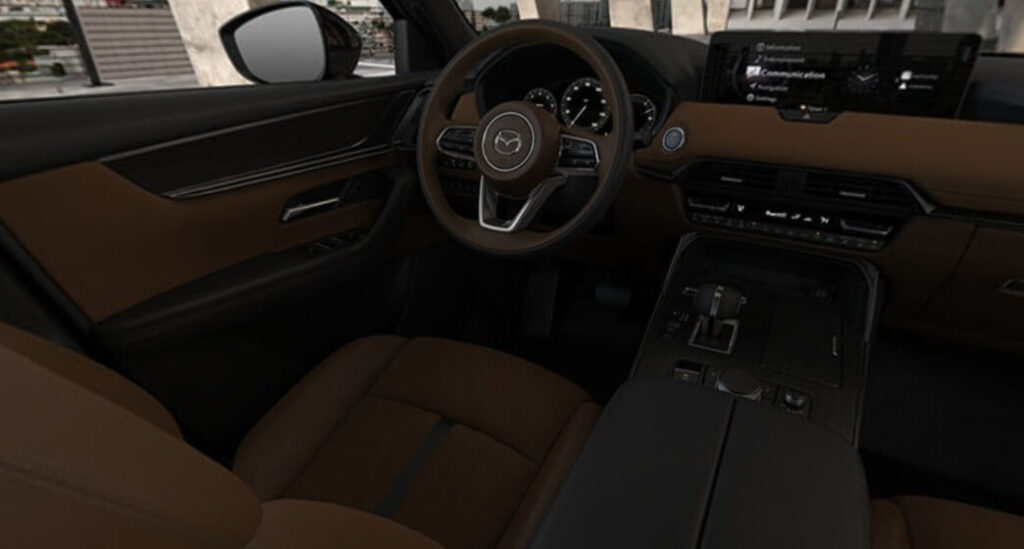
Given the differences between the Mazda CX-70 and CX-50 in size and specs, which of these two-row Mazda SUVs do you prefer?
Drivers looking for that classic Mazda agility and fun-to-drive feeling will be well-served with the adventurous Mazda CX-50 or the Mazda CX-5, its popular compact crossover SUV sibling. Both offer ample interior space and a choice of affordable, fuel-efficient four-cylinder power or elevated performance through an available 2.5-liter turbocharged engine.
For those seeking a more substantial SUV with more cargo space and a rear-biased AWD system, the Mazda CX-70 and CX-70 PHEV models are attractive options. Along with the CX-90 three-row variant, the new CX-70 midsize SUV delivers premium power and interior amenities at a highly competitive price compared to the luxury models it aims to outpace.
For more Mazda reviews and comparisons, stay tuned to MazdaMotoring and join our newsletter below for updates on Mazda news and upcoming vehicles:
Join Our Newsletter
Never miss a Mazda when you sign up for our email list:
Frequently Asked Questions
What’s the difference between Mazda CX-50 and CX-70 models?
The main differences between Mazda CX-50 and CX-70 models are their dimensions and powertrains. The CX-50 is a compact crossover SUV powered by a 2.5-liter or 2.5-liter turbo engine, paired with a six-speed automatic transmission, and features up to 56.3 cubic feet of cargo space. The CX-70 is a midsize SUV with an inline-six turbo engine or a PHEV powertrain and over 75 cubic feet of cargo space.
Which is better: the Mazda CX-70 or the Mazda CX-50?
Determining whether the Mazda CX-70 or the Mazda CX-50 is better depends on your personal preferences and budget. The CX-50 compact SUV is more agile and affordable, while the CX-70 midsize model is larger and more versatile, powerful, and premium. It’s best to tour and test drive both of these two-row Mazda SUVs to decide which is better for you.
Which is bigger: the Mazda CX-50 or the Mazda CX-70?
The Mazda CX-70 is bigger than the CX-50 and by a significant margin. The CX-70 measures over 200 inches long, while the smaller CX-50 is 185.8 inches long. The CX-70 is also wider and taller. While both models are two-row vehicles with five-passenger seating, the CX-70 is a midsize SUV, and the CX-50 is a compact crossover.

